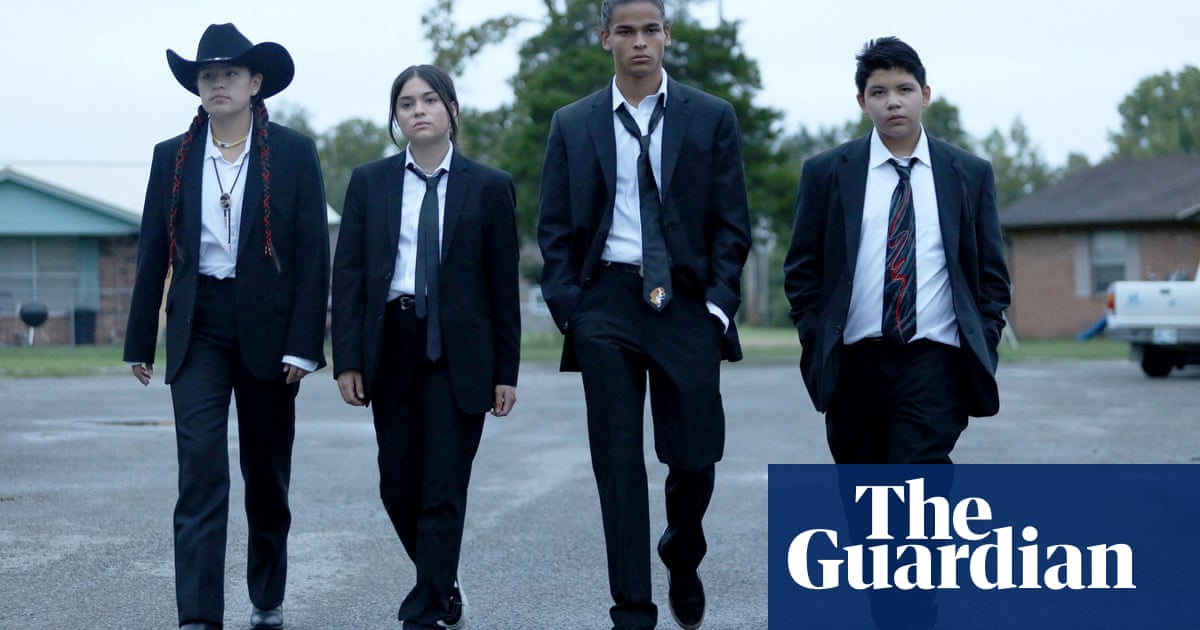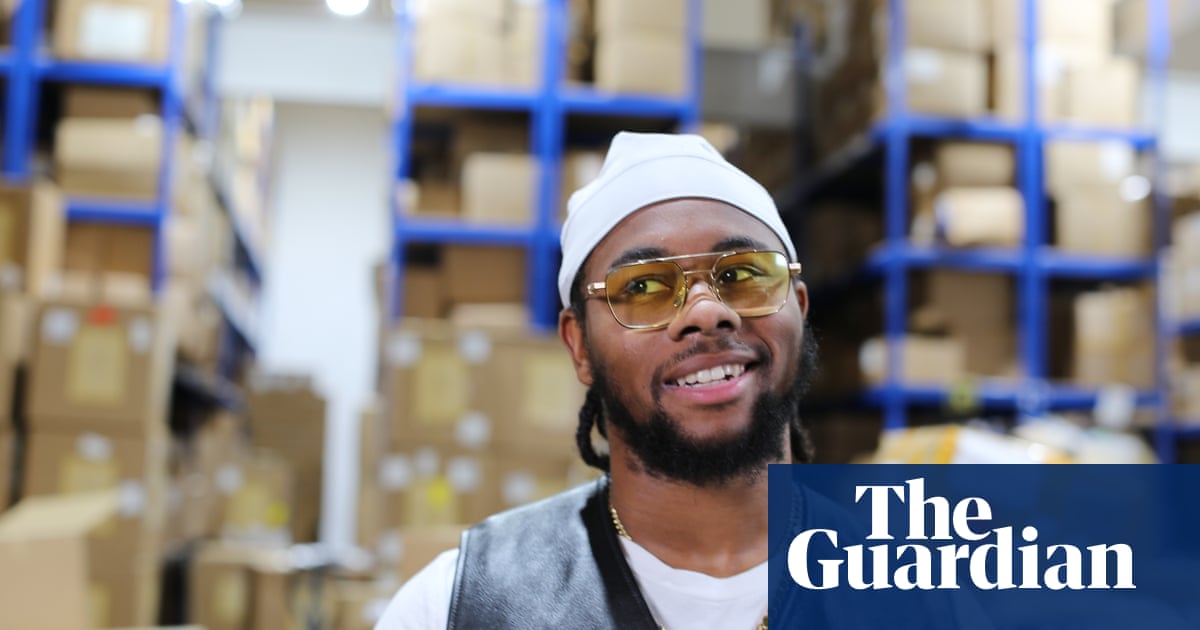
The state of Arizona is not among those that recognises Indigenous Peoples Day as a public holiday but this year, for the first time, the sprawling city of Phoenix is. An open-air market in a downtown park has been set up to celebrate all things Native American – jewellery, food, clothing – bringing their creators from all across the south-west.
At one end of the park is a low stage, and throughout the late summer day, musicians from Indigenous communities far across the US have been performing. Now, after dark, in the Arizona heat, Ed Kabotie is dangling his legs off the tailgate of a battered pickup, beer in hand.
Kabotie has driven down from the Hopi reservation 200 miles north of here to play with his reggae-rock band, the Yoties. And he is keen to tell his story, one that weaves in and out of his identity as Native American, as it does for most musicians here gathered together under the banner of Native Guitars Tour, a collective of Indigenous artists promoting Native music, art and fashion that advocates for greater cultural and economic representation.
Kabotie, who is Hopi, emphasises that the vision of Indigenous life that is presented online or in films is frequently generalised, crudely drawn or misleading.
“It’s important that people recognise that a Hopi is not a Havasupai, and a Havasupai is not an Apache,” he says. “We don’t all have casinos, and some of our governments hate that shit. We’re not all pow-wow people, and the pow-wow culture that you see isn’t necessarily an internal tribal culture. For some it is, for others it’s not.”
Where Kabotie is from, “a lot of people don’t have running water and electricity … we don’t have stores and it’s two hours to get to a hospital. All that being said, I like it. It’s not representative of every Native culture, it’s just one, whatever that is.”
Soon after we speak, Wavelengths, a Navajo-Zuni powerpop band from Shiprock, New Mexico, come on. “We’re trying to inspire ordinary Native Americans that you can do more than stay at home,” says their singer-guitarist Cody Waybenais. “I feel we are reaching a point where all of us, all Indigenous people, are collectively worldwide, all directions; all tribes are finally reaching a world platform.”
Notwithstanding the thinning crowd in Phoenix as the event winds down, the platform for Native voices is definitely expanding. On TV, hit shows such as Reservation Dogs are bringing Native actors and directors to the forefront; in others areas, too, there are signs of representational improvement, whether that’s in the form of the Navajo (by geography) model and activist Quannah Chasinghorse; the Santa Clara pueblo ceramicist Rose B Simpson; or Mashpee Wampanoag tribal citizen (and owner of the Sly Fox Den Too restaurant in Rhode Island), Sherry Pocknett, who has been named best chef in the north-east US by the James Beard awards for two years in a row.
“It’s time for us to express ourselves as we’re supposed to, because the oppression, genocide and everything affected us mentally and spiritually,” says Waŋbdí Wašté, drummer with Black Owl Society, a White Stripes-esque brother-and-sister rock act from the Yankton Sioux reservation in South Dakota.
The duo, whose parents were inducted into the Christian missionary school system which aimed to assimilate or “westernise” Native American children, are overtly political, focusing on water rights, minerals rights, and the issues of violence and the disappearance of Native people. “There has been a lot of healing throughout the past few generations and that for us is expressed in music,” says Wašté.
Her brother, who records as Buffalo Man, points out that when he started playing, people still seemed to think his family lived in tipis: “Anything that has to do with our reality is what we talk about. It’s not politics, religion, it’s our reality. We try to keep it real.”
But how real is real, and who gets to channel that reality, remains contentious. Devery Jacobs, a Canadian First Nations actor who stars in Reservation Dogs, recently critiqued Martin Scorsese’s Killers of the Flower Moon, calling it “painful, gruelling, unrelenting and unnecessarily graphic” in its depiction of a series of murders of members of the Osage Nation tribe in 1920s Oklahoma.
The bands in Arizona are not – and may never be – competing with the giants of the music business, but the point is clear: Native American arts and cultural expression that were once limited to their localities are gaining a wider reach. The social and economic filters that once isolated and constrained Indigenous voices are lifting.
The Native Guitars Tours is the brainchild of Jir Anderson, a Cochiti pueblo guitarist who fashioned his first guitar from a piece of a table and became a touring musician after getting a knock on the door from the Jamaican singer Fuzzy Bush. “In the 60s and 70s it was hard for Natives to make a living,” he says. “My parents were silversmiths, and I grew up right by the plaza, so I heard the thundery drums and my path became music,” Anderson recalls, referring to the large open space used for gatherings at the heart of pueblo villages in New Mexico.
His partner is Alicia Ortega, formerly the director of the All Pueblo Council of Governors and co-founder of Native Women Lead, a group that promotes the role of Native women in the pueblos. She is close with Deb Haaland, the US interior secretary and 35th generation New Mexican from the Laguna and San Felipe pueblos, not far from her own Pojoaque and Santa Clara.
“Everything was hidden, so at a certain point in time we weren’t able to go out and express ourselves without feeling judged,” says Ortega. “What we’re doing, in the present day, is celebrating very talented artists and musicians, and the amazing things Natives are doing right now, telling our own stories and advocating for the issues that we’re fighting for.
“We’re less than 3% of the US population struggling with invisibility and also with a romanticised, false narrative or struggling with poverty porn – other people’s idea of what Native people are, what we’re doing or where we come from,” Ortega continues, pointing out that it is only four decades since the American Indian Religious Freedom Act, guaranteeing freedom to worship through ceremonials and traditional rites, was passed. “Some people say it’s like walking in two worlds, but it’s not: it’s one multifaceted world. For us it’s just a way of life – our responsibilities to the communities we come from and the capitalistic, colonised world.”
Last month, at the international film festival in Santa Fe, the film and TV aspects of Native American cultural production came into view. Curated by Gary Farmer, the Cayuga nation and Haudenosaunee-Iroquois actor best known for his role in Jim Jarmusch’s Dead Man, the festival gave its top award to Sterlin Harjo, a Seminole from Oklahoma who co-created Reservation Dogs, which traces the exploits of four rebellious teens in a small town in Oklahoma’s Muscogee Nation.
The success of the show, which offered up-and-coming Native American film-makers episodes to direct, is not singular. There is also Dark Winds, a hit Navajo crime drama directed by Cheyenne-Arapaho Chris Eyre, who also made Smoke Signals; plus the comedy Rutherford Falls, which survived only two seasons, but gave Muskeg Lake Cree Nation actor Michael Greyeyes a leading turn.
“We’re seeing a lot of hot young film-makers coming out of the Santa Fe Institute for American Indian Arts and the University of New Mexico arts programme,” says festival director Jacques Paisner. The success of Rez Dogs and Dark Winds, he adds, “is creating more and more opportunities for Indigenous people to tell their stories on the screen”.
Despite the criticism of Killers of the Flower Moon, the production did at least consult with the Osage nation and feature many Native American actors. “While we’re happy that light is being shed on the history of Native people, it was told from a non-Native perspective.” says Ortega. “It was nice to see the Osage people involved, but it would have been better to see more focus on Native actors and the community. But it’s a step forward, right? I think we can be grateful for that. In the past, in movies, they would have had non-Natives acting as Natives and wouldn’t have consulted or had any connection with the tribal communities.”
Back in Phoenix, it is past midnight and still refusing to cool down. Ortega and Anderson are packing up for the six-hour drive back to Albuquerque, while Kabotie is gathering petrol money for the trek back home. He judges the night’s work to have been worth the trip, and a chance to bring “all that shit up but in a positive happy way. Someone once gave me a great compliment,” Kabotie recalls. “He said: so you guys are basically saying ‘fuck you’. But it’s fuck you creatively.”












